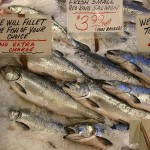by Catherine Haug, April 5, 2012
Did you know that almost all fruit trees are grafted?
- For most, the graft is at ground level, so that the tree and its root are not of the same species or variety, mostly to regulate the mature size of the tree. For example, apple can be grafted to rose root, which keeps the apple at a dwarf size.
- Different varieties of the same fruit can be grafted onto a common trunk; for example, bartlett and bosc pears on the same tree.
- Related species can be grafted onto a common trunk; for example the fruit basket tree, which has peach, apricot and plum.
Jean H decided she wanted more variety of fruit without adding more trees, so she learned how to graft branches of a different variety onto an existing tree. She sent me a couple video links, for any of you who would like to try this ancient technique. and I’ve added a few links with general info on growing fruit trees. (more…)

